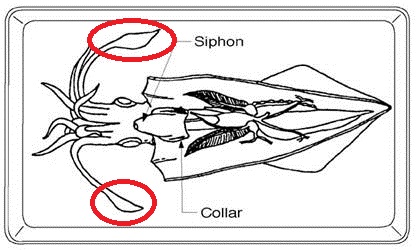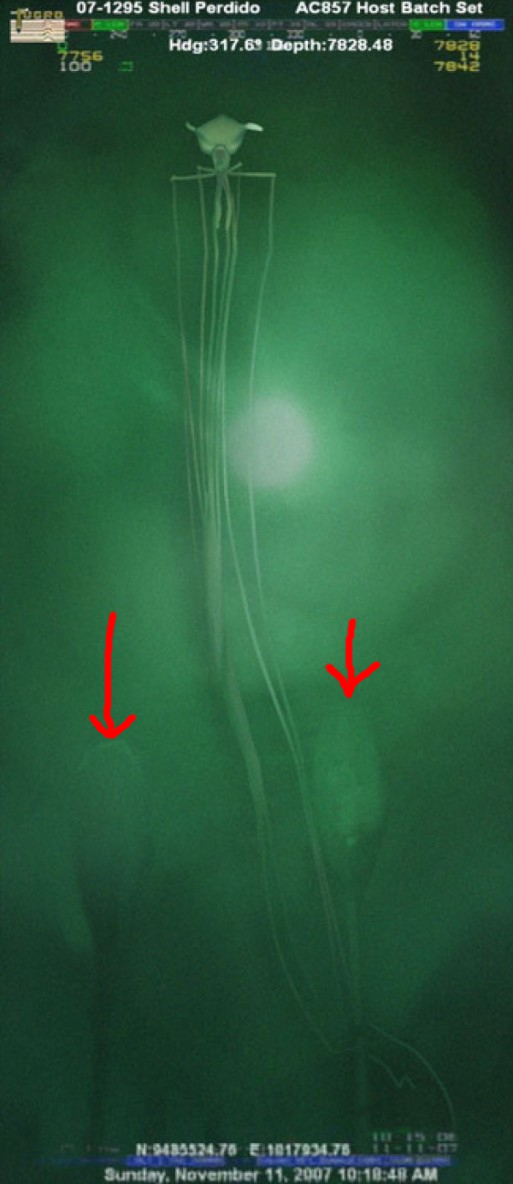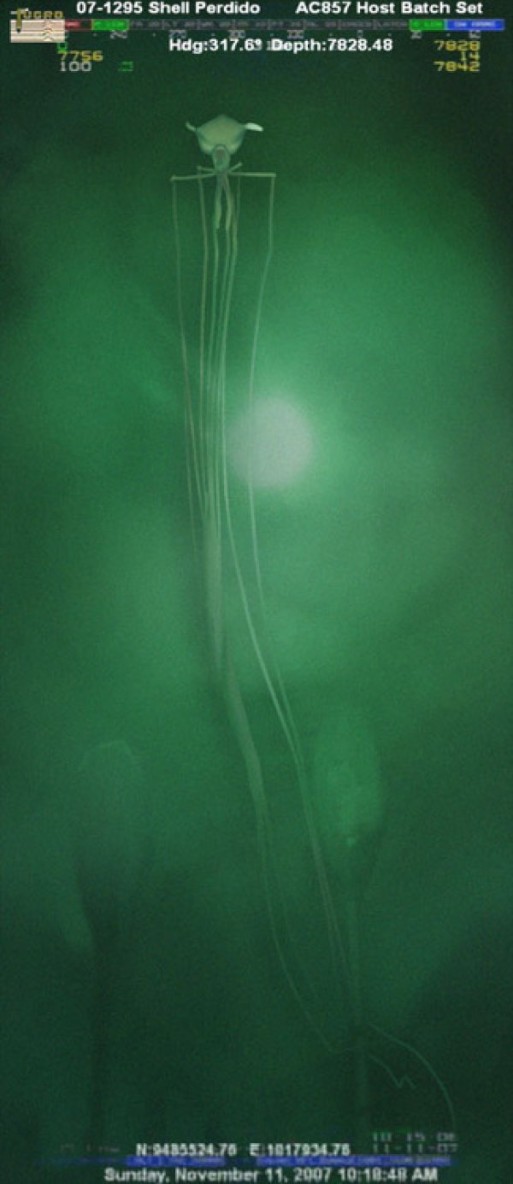It looks like you're using an Ad Blocker.
Please white-list or disable AboveTopSecret.com in your ad-blocking tool.
Thank you.
Some features of ATS will be disabled while you continue to use an ad-blocker.
share:
Biigs
That looks far far too much like the work of a photoshopper than a sea creature. sorry.
just one opinion against its genuine-ness
So did you watch the video in the OP?? The one that the image is taken from?
Cheese and rice!
Now just immagine what we still have to see. Thats just one of many Im sure, scary creatures at those depths. We have explored more in space than we have in our ocean!
Just think of all the scary, wonderful things. They should take that money for the space programe, and put it into deep water exploration!
Now just immagine what we still have to see. Thats just one of many Im sure, scary creatures at those depths. We have explored more in space than we have in our ocean!
Just think of all the scary, wonderful things. They should take that money for the space programe, and put it into deep water exploration!
reply to post by theantediluvian
I will admit, this thing freaked me out. It reminded me of the "tripods" from "War of the Worlds" from 2005. (A movie that freaked me out.) There's so much that lurks within the deep that we don't even know about that it's enough to keep me off and out of the ocean!
However from Wikipedia and other photos, the "fins" sit on it's body to help propel the creature, hence the name. From what I understand, it feeds on smaller organisms as well. Not much is understood about it's feeding habits though. And can we be considered a smaller organism? : Wink :
I will admit, this thing freaked me out. It reminded me of the "tripods" from "War of the Worlds" from 2005. (A movie that freaked me out.) There's so much that lurks within the deep that we don't even know about that it's enough to keep me off and out of the ocean!
However from Wikipedia and other photos, the "fins" sit on it's body to help propel the creature, hence the name. From what I understand, it feeds on smaller organisms as well. Not much is understood about it's feeding habits though. And can we be considered a smaller organism? : Wink :
blupblup
Biigs
That looks far far too much like the work of a photoshopper than a sea creature. sorry.
just one opinion against its genuine-ness
So did you watch the video in the OP?? The one that the image is taken from?
Actually i haddnt seen the video, i some how missed it 0.o
I will retract my post while i still can.
My apologies.
CranialSponge
Holy ripped nylons Batman.
Who needs ufo's when we've got creatures like this hiding in our oceans ?!
edit on 25-11-2013 by CranialSponge because: (no reason given)
There's a lot of truth in that statement.
Cephalopod intelligence has an important comparative aspect in the understanding of intelligence because it relies on a nervous system fundamentally different from that of vertebrates.[1] The cephalopod class of molluscs, particularly the Coleoidea subclass (cuttlefish, squid and octopuses), are considered the most intelligent invertebrates and an important example of advanced cognitive evolution in animals.
The scope of cephalopod intelligence is controversial, complicated by the challenges of studying these elusive and fundamentally different creatures. Classical conditioning of cephalopods has been reported, and one study (Fiorito and Scotto, 1992) even concluded that octopuses practice observational learning.[2] However, the latter idea is disputed by some,[3] and doubt has been shed on some other reported capabilities.[4] In any case, impressive spatial learning capacity, navigational abilities, and predatory techniques remain beyond question.
Wikipedia - Cephalopod intelligence
The last common ancestor between cephalopods and vertebrates would have been some sort of small, worm-like creature, living hundreds of millions of years ago and lacking a nervous system of the size and complexity necessary to give rise to intelligence. Vertebrate brains, though vastly different, exhibit a common underlying organizational structure that is not shared with cephalopods.
Cephalopod intelligence is effectively "alien."
What's scarier than a mass of tentacles lurking quietly in the cold dark depths, poised to seize prey and draw it into a viciously beaked mouth? One possessing an alien intelligence
theantediluvian
What's scarier than a mass of tentacles lurking quietly in the cold dark depths, poised to seize prey and draw it into a viciously beaked mouth? One possessing an alien intelligence

Ph'nglui mglw'nafh Cthulhu R'lyeh wgah'nagl fhtagn: "In his house at R'lyeh, dead Cthulhu waits dreaming".
reply to post by LewsTherinThelamon
I believe those belong to the squid. They look like the flap like tentacles with suckers on them that most squid use to grab their prey with (in this case the suckers are on the other side of the tentacles compared to the view of the camera). If that is indeed what they are, it makes the length of the creature even more remarkable when you take the perspective of the shot into account.

I believe those belong to the squid. They look like the flap like tentacles with suckers on them that most squid use to grab their prey with (in this case the suckers are on the other side of the tentacles compared to the view of the camera). If that is indeed what they are, it makes the length of the creature even more remarkable when you take the perspective of the shot into account.
edit on 26-11-2013 by DeadSeraph because: (no reason
given)

edit on 26-11-2013 by DeadSeraph because: (no reason given)
Actually its legs at the top look weak like branches. Do they snap? I think I'd be more impressed if this thing had more weight on it. It looks
spindly.
Not trying to kill this party, just being honest.
Not trying to kill this party, just being honest.
edit on 26-11-2013 by jonnywhite because: (no reason given)
DeadSeraph
reply to post by LewsTherinThelamon
I believe those belong to the squid. They look like the flap like tentacles with suckers on them that most squid use to grab their prey with (in this case the suckers are on the other side of the tentacles compared to the view of the camera). If that is indeed what they are, it makes the length of the creature even more remarkable when you take the perspective of the shot into account.edit on 26-11-2013 by DeadSeraph because: (no reason given)
Incorrect. They are buoys or some other part of the structure of the drilling rig from which the video was taken, and from that video is the OP's picture composited. They can be seen in more detail at :7 seconds of the video in the OP. They are blurred in the picture because of the compositing technique used.
Make no mistake, squid do not like you, they will attack you and if they can, they will kill you.
reply to post by Helious
From the Wikipedia page on the Humboldt squid:
Yep, they're not very cuddly at all.
From the Wikipedia page on the Humboldt squid:
They often approach prey quickly with all ten appendages extended forward in a cone-like shape. Upon reaching striking distance, they will open their eight swimming and grasping arms, and extend two long tentacles covered in sharp 'teeth', grabbing their prey and pulling it back towards a parrot-like beak, which can easily cause serious lacerations to human flesh. The whole process takes place in seconds.
Recent footage of shoals of these animals demonstrates a tendency to meet unfamiliar objects aggressively. Having risen to depths of 130–200 m (430–660 ft) below the surface to feed (up from their typical 700-metre (2,300-ft) diving depth, beyond the range of human diving), they have attacked deep-sea cameras and rendered them inoperable. Reports of recreational scuba divers being attacked by Humboldt squid have been confirmed.[16][17] One particular diver, Scott Cassell,[18] who has spent much of his career videotaping this species, has developed body armor to protect against attacks.[19] Each of the squid's suckers is ringed with sharp teeth, and the beak can tear flesh, although they are believed to lack the jaw strength to crack heavy bone.[3]
Yep, they're not very cuddly at all.
Helious
Make no mistake, squid do not like you, they will attack you and if they can, they will kill you.
I'm not saying a squid attack has never happened, because clearly they have, but it's a complete misconception to think of them as violent aquatic maniacs, hellbent on feasting upon human flesh. That Animal Planet video does a nice job of making it seem that way though, who'd have thought that a segment entitled "Man-Eating Super Squid" might go out of it's way to sensationalize things?
Although Humboldt squid are certainly among the most aggressive of squid species, to the contrary-
Cephalopod Attack
There is some disagreement on the veracity of Humboldt squid aggression. Some scientists claim the only reports of aggression towards humans have occurred when reflective diving gear or flashing lights have been present, acting as provocation. Roger Uzun, a veteran scuba diver and amateur underwater videographer, swam with a swarm of Humboldt squid for approximately 20 minutes, later saying they seemed more curious than aggressive.[6] When not feeding or being hunted, Humboldt squid exhibit curious and intelligent behavior.[7]
Also,
Study Finds Squid are Fairly Docile
They found, the squid would've had a slower metabolism and so moved slower than expected, waiting for prey, rather than running it down. "Everyone thought it was an aggressive predator, but the data suggests otherwise," Rosa told LiveScience. "It's a squid that weights half a ton with hooks in its tentacles, but our findings show it’s more like just a big blob."
Contrary to the image of Kraken-like shellfish attacking ships and dragging sailors to their deaths, this new data paints a picture of a mostly sedentary creature, Rosa said. Rather than swimming after prey, the colossal squid would wait to ambush passing fish.
So let's not be afraid of our little aquatic squid buddies, as long as you're not wearing a bunch of shiny sh_t that makes you look like a school of delicious mackerel, you should be okay around them. Of course, one should always be careful when treading into the domains of animals, as their motives and whims are often mysterious and unforeseeable...
That said, if there's anything I learned from The Little Mermaid, it's that-
Under the sea
Darling it's better
Down where it's wetter
Take it from me
Up on the shore they work all day
Out in the sun they slave away
While we devotin'
Full time to floatin'
Under the sea
theantediluvian
From Wikipedia:
The bigfin squids are a group of rarely seen cephalopods with a distinctive morphology. They are placed in the genus Magnapinna and family Magnapinnidae. Although the family is known only from larval, paralarval, and juvenile specimens, some authorities believe the adult creature has also been seen; several videos have been taken of animals nicknamed the "long-arm squid", which appear to have a similar morphology. Adult specimens have never been captured or sampled--it remains uncertain if they are the same genus, or only distant relatives.
Some of you will remember seeing the 2007 video from a Shell Oil ROV, taken at a depth of about 1.5 miles, showing one of these elusive creatures.
from the same Wikipedia page:
On November 11, 2007, a new video of a long-arm squid was filmed off Perdido, a drilling site owned by Shell Oil Company, located 200 statute miles (320 km) off Houston, Texas in the Gulf of Mexico.[7]
The specimens in the videos looked very distinct from all previously known squids. Uniquely among cephalopods, the arms and tentacles were of the same length and looked identical (like extinct belemnites). The appendages were also held perpendicular to the body, creating the appearance of strange "elbows". Most remarkable was the length of the elastic tentacles, which has been estimated at stretching up to 15–20 times the mantle length. Estimates based on video evidence put the total length of the largest specimens at 8 metres (26 ft) or more.[8] On close ups of the body and head, it is also apparent that the fins are extremely large, being proportionately nearly as big as those of bigfin squid larvae. While they do appear similar to the larvae, no specimens or samples of the adults have been taken, leaving their exact identity unknown.
An unknown person has generated a composite image from the frames of this video and the result is pretty horrifying, made no less so by the green hue. The image has been making the rounds and I hadn't seen it on ATS so I thought I'd share.
Another mental image to keep me from going in much further than waist deepedit on 25-11-2013 by theantediluvian because: (no reason given)
forget the little spider droid looking thing look at the two paddle looking things at the bottom. Large squid have this paddle type appendages and if they are that big how large is the actual squid. so How big is the spider droid thing because if those paddle appendages are from a large fin squid that thing is huge as bis as a ship
reply to post by theantediluvian
i dont know why but i feel that thing wants to claw my face off...just a vibe.
i dont know why but i feel that thing wants to claw my face off...just a vibe.
reply to post by ExquisitExamplE
I don't know about the author of that article, but a bus-sized creature lurking 3,000 feet in the frigid inky blackness of the arctic ocean, silently waiting to ambush unsuspecting pray with tentacles bearing razor sharp hooks doesn't seem to fit my own definition of "docile."
Crocodiles are ambush predators too, and I'm not going swimming with them either.
I don't know about the author of that article, but a bus-sized creature lurking 3,000 feet in the frigid inky blackness of the arctic ocean, silently waiting to ambush unsuspecting pray with tentacles bearing razor sharp hooks doesn't seem to fit my own definition of "docile."
Crocodiles are ambush predators too, and I'm not going swimming with them either.
reply to post by theantediluvian
If that thing learns to walk we're looking at war of the worlds.
Somebody phone Tom Cruise.
If that thing learns to walk we're looking at war of the worlds.
Somebody phone Tom Cruise.
reply to post by jhn7537
It looks like the Alien attack pods from "War of the Worlds" the new one of course.
It looks like the Alien attack pods from "War of the Worlds" the new one of course.
reply to post by theantediluvian
Well the overgrown squid is spooky but what the heck, do you guys no see the part of the giant arse thing coming n from bottom of screen lol. I am more scared of what looks like wants to eat it lol.
The Bot
Well the overgrown squid is spooky but what the heck, do you guys no see the part of the giant arse thing coming n from bottom of screen lol. I am more scared of what looks like wants to eat it lol.
The Bot
new topics
-
Claim: General Mark Milley Approved Heat and Sound Directed Energy Weapons During 2020 Riots
Whistle Blowers and Leaked Documents: 41 minutes ago
top topics
-
Let's talk planes.
General Chit Chat: 17 hours ago, 5 flags -
Claim: General Mark Milley Approved Heat and Sound Directed Energy Weapons During 2020 Riots
Whistle Blowers and Leaked Documents: 41 minutes ago, 0 flags
active topics
-
Post A Funny (T&C Friendly) Pic Part IV: The LOL awakens!
General Chit Chat • 7998 • : underpass61 -
Claim: General Mark Milley Approved Heat and Sound Directed Energy Weapons During 2020 Riots
Whistle Blowers and Leaked Documents • 1 • : BeyondKnowledge3 -
The Truth about Migrant Crime in Britain.
Social Issues and Civil Unrest • 20 • : bastion -
Gravitic Propulsion--What IF the US and China Really Have it?
General Conspiracies • 20 • : Xtrozero -
Biden to award Presidential Citizens Medal to Liz Cheney and Bennie Thompson
US Political Madness • 20 • : xuenchen -
Judge rules president-elect Donald Trump must be sentenced in 'hush money' trial
US Political Madness • 39 • : xuenchen -
January 6th report shows disturbing trend (nobody is shocked)
US Political Madness • 60 • : fringeofthefringe -
RFK JR endorses Trump
2024 Elections • 47 • : fringeofthefringe -
OK this is sad but very strange stuff
Paranormal Studies • 9 • : charlyv -
Meta Llama local AI system is scary good
Science & Technology • 43 • : Arbitrageur



